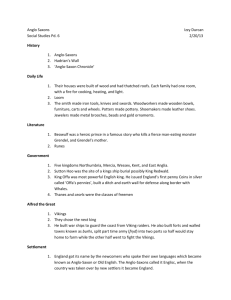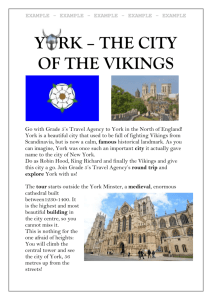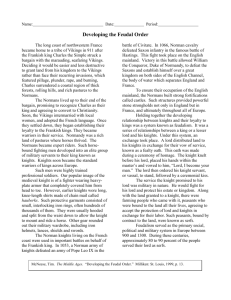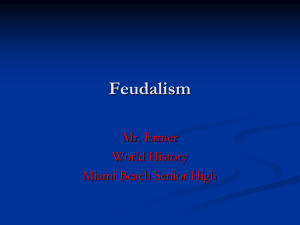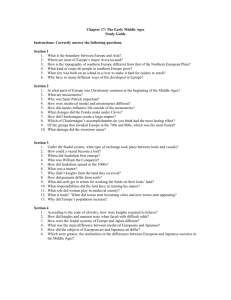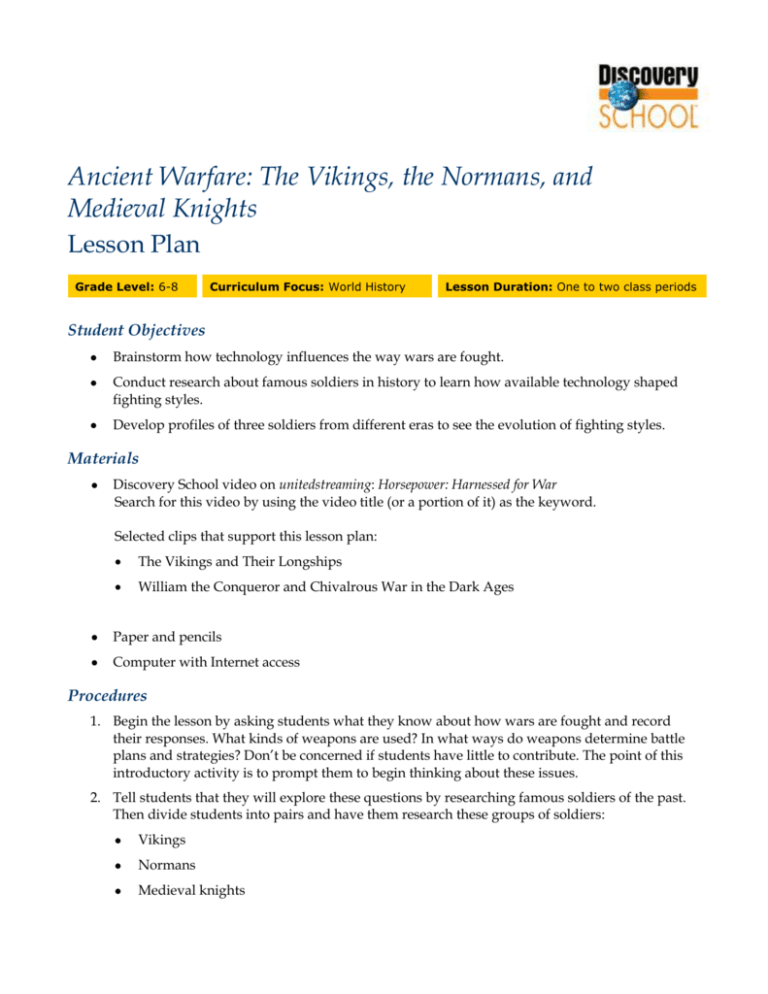
Ancient Warfare: The Vikings, the Normans, and
Medieval Knights
Lesson Plan
Grade Level: 6-8
Curriculum Focus: World History
Lesson Duration: One to two class periods
Student Objectives
Brainstorm how technology influences the way wars are fought.
Conduct research about famous soldiers in history to learn how available technology shaped
fighting styles.
Develop profiles of three soldiers from different eras to see the evolution of fighting styles.
Materials
Discovery School video on unitedstreaming: Horsepower: Harnessed for War
Search for this video by using the video title (or a portion of it) as the keyword.
Selected clips that support this lesson plan:
The Vikings and Their Longships
William the Conqueror and Chivalrous War in the Dark Ages
Paper and pencils
Computer with Internet access
Procedures
1. Begin the lesson by asking students what they know about how wars are fought and record
their responses. What kinds of weapons are used? In what ways do weapons determine battle
plans and strategies? Don’t be concerned if students have little to contribute. The point of this
introductory activity is to prompt them to begin thinking about these issues.
2. Tell students that they will explore these questions by researching famous soldiers of the past.
Then divide students into pairs and have them research these groups of soldiers:
Vikings
Normans
Medieval knights
Ancient Warfare: The Vikings, the Normans, and Medieval Knights
Lesson Plan
2
3. Ask students to consider these questions during their research:
What form of transportation did each group of soldiers use?
What weapons did each group use?
What strategies did each group use to fight battles?
How did each group try to ensure its personal safety?
What, if anything, do we know about how each group learned from those who came before
them?
4. Give students time to conduct their research in class. Useful Web sites for each group are listed
below. Students also may want to watch Horsepower: Harnessed for War as part of their
research.
Vikings
http://www.strangehorizons.com/2001/20010827/vikings.shtml
http://kidzlit.bravepages.com/Articles/vikings.html
http://www.runenews.com/mythology.shtml
http://www.runegame.com/myth.php?loc=Warfare
Normans
http://freepages.genealogy.rootsweb.com/~chatsol/viking.htm
http://members.tripod.com/~Battle_of_Hastings/Hastings.htm
http://www.innish.btinternet.co.uk/History/AncientInnish.htm
Medieval Knights
http://www.pbs.org/wnet/warriorchallenge/knights/profile_job.html
http://kevin.lps.org/Middle_ages/castles/weapons/knight.html
http://www.cyberlearningworld.com/nhhs/compapps/workshop/medieval/knights.htm
http://historymedren.about.com/library/weekly/
http://members.tripod.com/~hkcarms/knights.html
aa030598a.htm?once=true&
5. Using what they’ve learned in their research, have each pair write a profile for each group of
soldiers. Remind them to address the questions in Step 3.
6. If time allows, give students an opportunity to share their work. Conclude the lesson by listing,
as a class, the war technology that was considered “state of the art” for the Vikings, Normans,
and medieval knights. Ask students how available transportation and weapons shaped the
ways these soldiers fought wars? How did war technology affect the outcome of their wars?
Assessment
Use the following three-point rubric to evaluate students’ work during this lesson.
3 points: Students researched the topic carefully and thoroughly, developed a creative and
comprehensive summary of their research, actively participated in class discussions.
Published by Discovery Education. © 2005. All rights reserved.
Ancient Warfare: The Vikings, the Normans, and Medieval Knights
Lesson Plan
2 points: Students researched the topic, developed a competent summary of their research,
participated somewhat in class discussions.
1 point: Students did not complete their research, developed a summary with gaps and
misunderstandings, did not participate in class discussions.
3
Vocabulary
Battle of Hastings
Definition: Famous 1066 battle in which Norman ruler William the Conqueror defeated the
English and established Norman rule in England
Context: The effective use of archers on the battlefield allowed William the Conqueror to defeat
Harold of England at the Battle of Hastings
code of chivalry
Definition: The rules a knight followed which included fighting against evil and injustice, and if
necessary, defending his church and land with his life
Context: Although knights were supposed to follow the code of chivalry, in reality many were
cruel and ruthless and treated people from lower classes very harshly.
knight
Definition: Soldiers during the Middle Ages (1100-1300) who were equipped and trained to fight
battles on horseback
Context: Knights went through a long training program in which they first had to become a
page and then a squire before they were knighted.
Normans
Definition: A group of people descended from the Vikings who first settled in France and
eventually conquered England
Context: Over time, the Normans blended with the English and contributed a great deal to
English literature and architecture.
Vikings
Definition: Norsemen soldiers who came from the countries known today as Norway, Denmark,
and Sweden; the Vikings were known for raiding the coasts of Europe and exploring the world
between 789 and 1100 A.D.
Context: Although once thought to be barbarians, the Vikings are now recognized as having a
sophisticated culture and being expert navigators and sailors.
Academic Standards
Mid-continent Research for Education and Learning (McREL)
McREL's Content Knowledge: A Compendium of Standards and Benchmarks for K-12 Education
addresses 14 content areas. To view the standards and benchmarks, visit link:
http://www.mcrel.org/compendium/browse.asp
Published by Discovery Education. © 2005. All rights reserved.
Ancient Warfare: The Vikings, the Normans, and Medieval Knights
Lesson Plan
4
This lesson plan addresses the following national standards:
Language Arts—Viewing: Uses viewing skills and strategies to understand and interpret
visual media; Writing: Uses the general skills and strategies of the writing process, Gathers
and uses information for research purposes
Technology— Understands the relationships among science, technology, society, and the
individual
History—World History Across the Eras: Understands long-term changes and recurring
patterns in world history
The National Council for the Social Studies (NCSS)
NCSS has developed national guidelines for teaching social studies. To become a member of NCSS,
or to view the standards online, go to http://www.socialstudies.org
This lesson plan addresses the following thematic standards:
Culture
Power, Authority, and Governance
Science, Technology, and Society
Global Connections
Published by Discovery Education. © 2005. All rights reserved.
Warfare: The Vikings, the Normans, and Medieval Knights
5
AncieAncient
Lesson Plan
nt Support Materials
WarfDevelop custom worksheets, educational puzzles, online quizzes, and more with the free teaching tools
on the Discoveryschool.com Web site. Create and print support materials, or save them to a
are: offered
Custom Classroom account for future use. To learn more, visit
http://school.discovery.com/teachingtools/teachingtools.html
The
Vikin
gs,
the
Norm
ans,
and
Medi
eval
Knig
hts
Published by Discovery Education. © 2005. All rights reserved.


